
Sunday December 19, 2004
New Formula For Speed!
Scalextric 2004 Renault and Williams/BMW F1
 The latest Formula One model from Scalextric has
arrived, and with it comes a few surprises. If you are the type of enthusiast
who enjoys blistering fast performance from your slot cars, I can safely say
this model should appeal to your nature. Scalextric has already created some
very fast and smooth running slot cars in the past, but now the bar...among
other things...has been raised.
The latest Formula One model from Scalextric has
arrived, and with it comes a few surprises. If you are the type of enthusiast
who enjoys blistering fast performance from your slot cars, I can safely say
this model should appeal to your nature. Scalextric has already created some
very fast and smooth running slot cars in the past, but now the bar...among
other things...has been raised.
Before we get to the performance of these beasts, you might take notice of the overall appearance of the models. Perhaps it is just me, but Scalextric has really put in a great effort towards scale detail and realism with these models. I look back at the rumbling old single-seater of years past and then look at a model like this and think how far they have come.
Intricate air ducts with fine screen mesh visible, clean body shape and excellent paint and Tampo markings engulf these models. Of course, with all slot cars in our hobby nothing is perfect, but my eyes tell me that Scalextric has done an excellent job in capturing these cars in our scale.
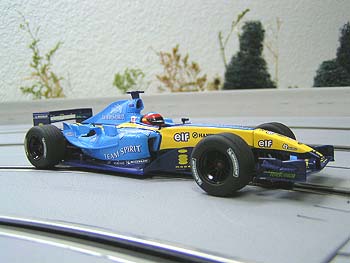
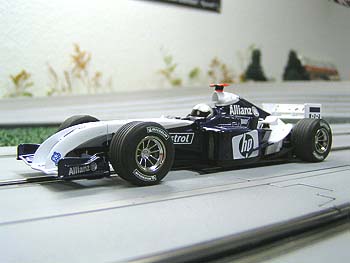
I am one of those folks that appreciate the small details, especially in the paint department. The overall finish of both models makes them quite striking in my opinion, and just increases the fun factor while racing them.
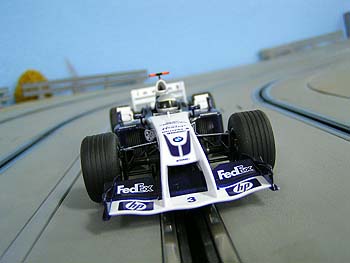
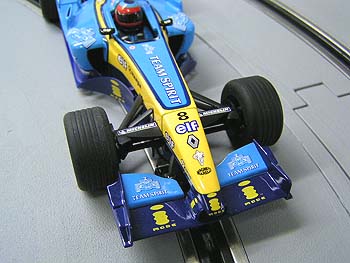
For a few more larger photos click here
You might have already heard about the tires on these models. The shape of them is a little better than previous models with slightly larger rounded sidewalls. The compound of this tire seems a little softer than previous models, but I cannot verify this. I am going strictly on "feel" and I could certainly be wrong. In any event, these tires provide excellent grip on our plastic tracks when using the magnet, and required only minimal sanding to get a true contact patch from them.
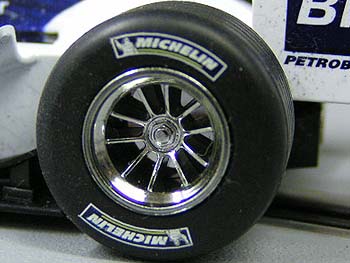
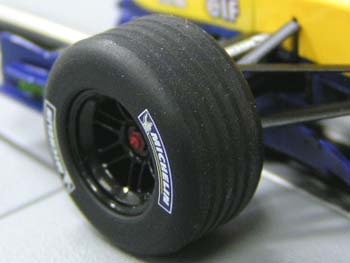
Turning the model over we see the new guide system is utilized. With all the strides Scalextric is making with models such as these, I still cannot understand why we cannot make a guide with a little more depth. If there was something I would change on this model, this would be step one. The guide height is very good however, with the front wheels just slightly touching the ground. I will say that for those who race on routed or plastic tracks that have banking, or are non-magnet, that a deeper guide will certainly improve performance and minimize de-slotting.
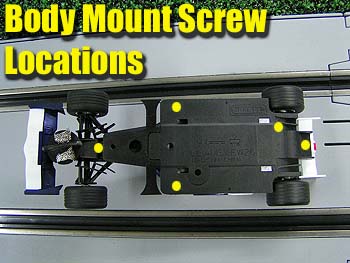
These models also come with a front pocket design for allowing you to add an additional button magnet up front. I have had trouble in the past with these pockets as they were fragile and sometimes would break just trying to remove them. However, these models had no issues and both pockets were removed with no damage.
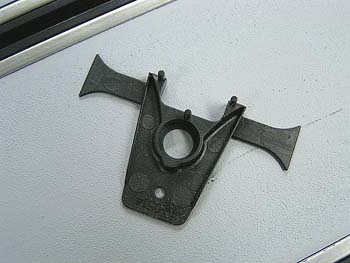
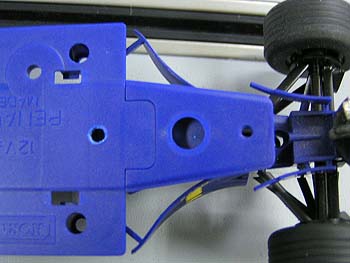
This pocket also appears to have the hole for digital conversion for those who want it. There is not much room up front for the standard digital chip but Scalextric has announced a new chip for F1/Single Seater/IRL models. When these are released, I am certain that we will test them to see how well they fit.
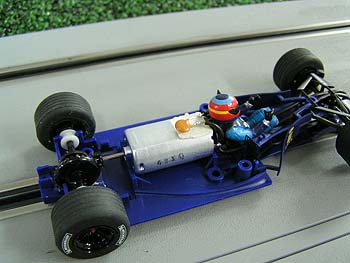
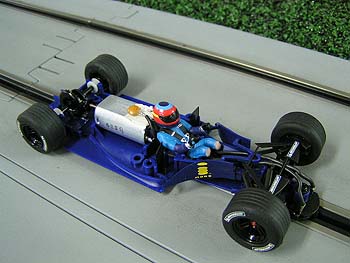
There are 4 screws for the chassis and one for the rear wing and all were easily removed to expose the next big surprise. Scalextric has fitted these F1 models with a new motor. This is the same motor that was found in the Moto GP and for some this is a good thing, and for others it may not. The gearing is the same however with a 9 tooth pinion and 27 tooth crown. I still do not have any confirmed RPM ratings of this motor, but I assure you it has more torque and more top speed than the standard Mabuchi motors found in earlier models.
Does this mean if you already have a field of F1 models they will not be competitive out of the box? Well the answer depends on your driving style and possibly your layout design, but for the most part the answer is no. If your layout has very long straight sections, this new motor will pull away from the rest of the pack easily. On smaller layouts, the racing is a little more even as although the older motor is a little slower, the overall control was easier for me to pilot. I tested this model on both our new 4 x 20 foot oval, and our 4 x 16 foot Dixon Hills road course. On the oval with the long straights, this new F1 clearly is the dominant model. However, moving over to the smaller road course things changed rather quickly. I found that the older model was just easier to control in the tighter sections of the track and this helped even things up. The new F1 is still a shade faster of course. Once I got the feel of it and settled down, my lap times were an average of 3.6 seconds compared to the older model with an average of 3.8. I say "older"...but really it is just one year old. I reviewed the Renault back in January of this year.
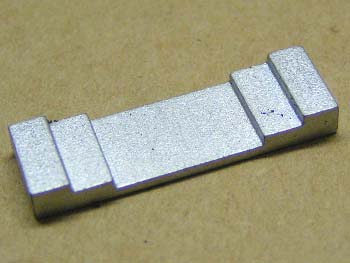
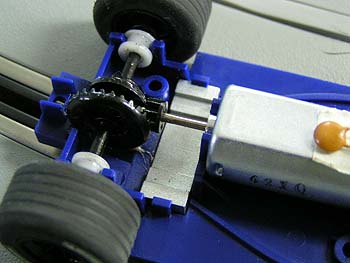
One reason that the racing is this close is the magnet differences. This new model uses the graduated bar magnet that increases the thickness towards the ends. The idea of this design is that magnetic downforce increases as the car begins to slide out, allowing the thicker sections to work their magic. The problem is that although this sounds good, application of it for me was a different story. When you do push this model to it's limit and the thicker end of this magnet does break free, you have virtually no time to correct it and it snaps off the track. The older model has a single standard bar magnet that gives plenty of downforce and it is even throughout. This helped me judge when to back off a little easier, therefore helping me keep the lap times and the racing closer. But the stronger motor in the new models, once tamed, clearly leads the way. Braking and acceleration are very crisp and you can really tuck this beast deep into the corners. Punching out of turns is also where you notice the added strength. Again, I want to stress that this is just my findings due to my driving style, you might find this model to be vastly superior to older versions and enjoy the added power.
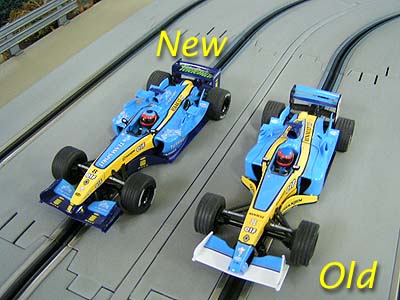
However, what about non-magnet use? Well the older Renault impressed me with it's handling and so did both of these new releases. The wheels and tires along with the axles were all straight, round and true. The main thing is that it really needs silicone tires such as the Indy Grips #1008 to get optimal performance. The standard rubber is round enough, but the grip level without the magnet was very low on our track. With just the magnets removed in stock form, this car had a best lap time of 6.5 seconds. It was just all over the place sliding around the corners. Sanding and cleaning the tires helps of course, but soon they just get dirty again and the sliding begins. By just adding the Indy Grips we immediately seen a difference in overall control and could consistently have our lap times in the 5.0 second range. This is a large margin indeed. It also was very apparent that this stronger motor became more of a handful without the magnet. Some enthusiasts like all the extra power and can handle it quite well, and if you fall into this category then you should find this F1 to your liking.
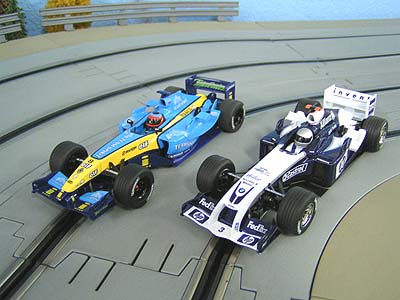
Of course, adding some weight here and there to make it handle a little better is what most of you will do running non-magnet. There is more room to work with lead than you might think too. On the sides of the motor as well as the original rear bar magnet pocket, and front bar magnet pocket located just in front of the motor is just a few areas that you can squeeze some added weight. You could even apply some in the front magnet pocket area. With adding the Indy Grips which raises the model up slightly, there is even room underneath for very thin sheet lead application.
For those that like more information, here is the technical data on this model according to Scalextric:
|
Renault |
Williams |
|
Front axle width: 58 mm |
Front axle width: 58 mm |
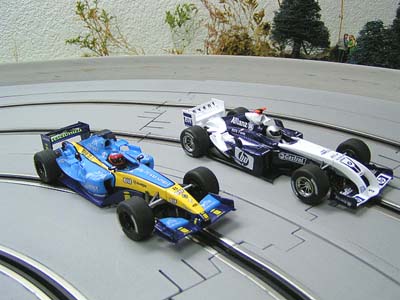 In the end I have to give Scalextric the nod for creating not
only an attractive set of models, but ones that are smooth to operate and
satisfy the need for speed. With many versions planned for this new line, having
a matched and even field is readily available. This fact is becoming very
important in our racing as some models seem to vanish all too quickly just as we
are starting to get interested in them. Fans of the series will no doubt want to
add at least a pair to their current line-up and beginners should be pleased
with the out of the box performance it provides.
In the end I have to give Scalextric the nod for creating not
only an attractive set of models, but ones that are smooth to operate and
satisfy the need for speed. With many versions planned for this new line, having
a matched and even field is readily available. This fact is becoming very
important in our racing as some models seem to vanish all too quickly just as we
are starting to get interested in them. Fans of the series will no doubt want to
add at least a pair to their current line-up and beginners should be pleased
with the out of the box performance it provides.
-Harry
As always feel free to contact me about this article or just the hobby in general at harry@homeracingworld.com, or better yet drop into our Message Forum and share your thoughts with other enthusiasts!
Thanks go to Scalextric-USA for providing us with these models!